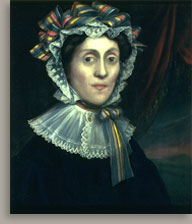 John Ritto Penniman John Ritto Penniman
Elizabeth Bartlett Nolen (Mrs. Henry Nolen), about 1828–30
Description
Elizabeth Bartlett Nolen (Mrs. Henry Nolen) is a bust-length portrait of a woman turned three-quarters to the right. Her head is turned slightly forward, and she looks toward the viewer. Her tightly curled, dark-brown hair is visible at the sides of her head, which is mostly covered by a white, lace-edged bonnet. A wide pink and white striped ribbon ornaments the bonnet. Light falls across the woman’s face from the upper left to lower right, casting shadows on the right side of the face and under the chin. The sitter’s eyes are blue, and the artist has painted the proper right eye larger than the left one. An earring hangs from her proper right ear. The earring has two flower-like tiers: a smaller one above that has gold petals and a white center, and a larger one below that has a gold center, white petals, and a very fine gold outline. Her black dress has a pleated front, though the difference between the lights and darks of the folds is now barely distinguishable. The woman also wears a two-layered, white, translucent, pleated collar with a border of X-shaped stitches. The background varies from lighter brown at left to darker brown at right.
Biography
Elizabeth Bartlett (1783–1879) was the daughter of Susan Swift Bartlett (1757–1813) and William Bartlett (1750–1837), a hatter, of Pleasant Street, Boston.1 On December 16, 1812, Elizabeth married Henry Nolen (1782–1860), a carriage painter who trained in Roxbury and was active in Boston at the time of their marriage. Nolen’s shop was on Orange Street in 1809 and on Pleasant Street by 1813; both addresses were near his in-laws’ home. In 1805, Elizabeth’s sister Susanna (or Susan) Barlett (1781–1870) had married the artist Penniman whose shop was also on Pleasant Street.2
In 1813, shortly after the death of Elizabeth Nolen’s mother, the Nolens and William Bartlett moved to West Brookfield, Massachusetts, about twenty miles west of Worcester. The Nolens had at least five children, the first of whom was born in 1813. In 1819, Henry Nolen purchased a house in West Brookfield and, in partnership with a carriage maker named Nathaniel Spear, built a shop on the common in that town. In 1837, William Bartlett died. Two years later the Nolens moved to Philadelphia, where they remained until their deaths.
Analysis
Elizabeth Nolen and John Ritto Penniman were brother- and sister-in-law. The sitter’s husband Henry Nolen—who was, like Penniman, a decorative painter—had a shop in the early 1810s in Boston on Pleasant Street near Penniman’s studio. Such personal and professional connections between Penniman and his portrait sitters were typical. Indeed,
 |
 |
| Figure 1. John Ritto Penniman, Henry Nolen, about 1828–30, oil on basswood panel, 19 13 /16 x 16 1/2 in. (57 x 42 cm) Worcester Art Museum, Eliza S. Paine Fund, 1982.10. |
|
 |
|
Figure 2. John Ritto Penniman, Sally Penniman (Mrs. Franklin Ruggles), about 1830, oil on panel, 21 x 18 in. (53.3 x 45.7 cm), private collection.
|
|
family members were his most frequent subjects. About 1805, he painted his wife (location unknown) and mother-in-law (location unknown). About 1814, Penniman portrayed his daughter Susan (location unknown), and about 1816, he did a watercolor and ink wash drawing of his sister Sally (Mrs. Franklin Ruggles) (private collection). In 1821, he created a likeness of his daughter Lucretia (location unknown). About 1830, Penniman made oil portraits of Sally and Franklin Ruggles (both private collection), and about 1831, he created an oil painting of his father-in-law (private collection).3
Based upon style, it seems likely that Penniman painted Elizabeth Bartlett Nolen (Mrs. Henry Nolen) and its companion Henry Nolen (fig. 1) about 1828–30, perhaps fifteen or more years after the Nolens had moved from Boston to West Brookfield. Penniman visited western Worcester County often in the 1820s and settled there himself in 1830, the year that both of his parents died. Mrs. Nolen’s portrait is painted in a style similar to the portrait of the artist’s sister, Sally Penniman (Mrs. Franklin Ruggles) (fig. 2). The two paintings are especially alike in the crisp rendering of lace and ribbons as well as in the somewhat simplified modeling of the faces. Each painting is on panel, is approximately the same size, and is compositionally alike. In both works, Penniman placed the figure at the left side of the image with the proper right shoulder cropped by the left edge of the panel. Both figures are turned three-quarters right, and the eyes return the gaze of the viewer.
The style in which Mrs. Nolen is depicted reflects Penniman’s successful synthesis of his work as a decorative painter and a portraitist. He gave up the painterly brushstrokes and generalized landscape backgrounds that are found in such early paintings as Portrait of a Man. Instead, in his mature works, Penniman used bright colors, tight rendering, and careful attention to costume details to craft a decorative style of portraiture. Such likenesses were apparently pleasing to the craftsmen, farmers, and country lawyers and doctors who sat for Penniman in the small towns of central Massachusetts.
Notes
1. The biography of Elizabeth Nolen is based upon unpublished research that was conducted by Carol Damon Andrews and was kindly shared by her.
2. Andrews 1981, 161 n. 21.
3. For an illustration of the 1814 portrait of Sally Ruggles, see Andrews 1981, 153; for the later oil paintings of Sally (fig. 2 of this entry) and Franklin Ruggles, 155; and for William Bartlett, 163. For checklist information on the unlocated portraits, see Andrews 1981, 165, 166, and 168. |
 John Ritto Penniman
John Ritto Penniman
